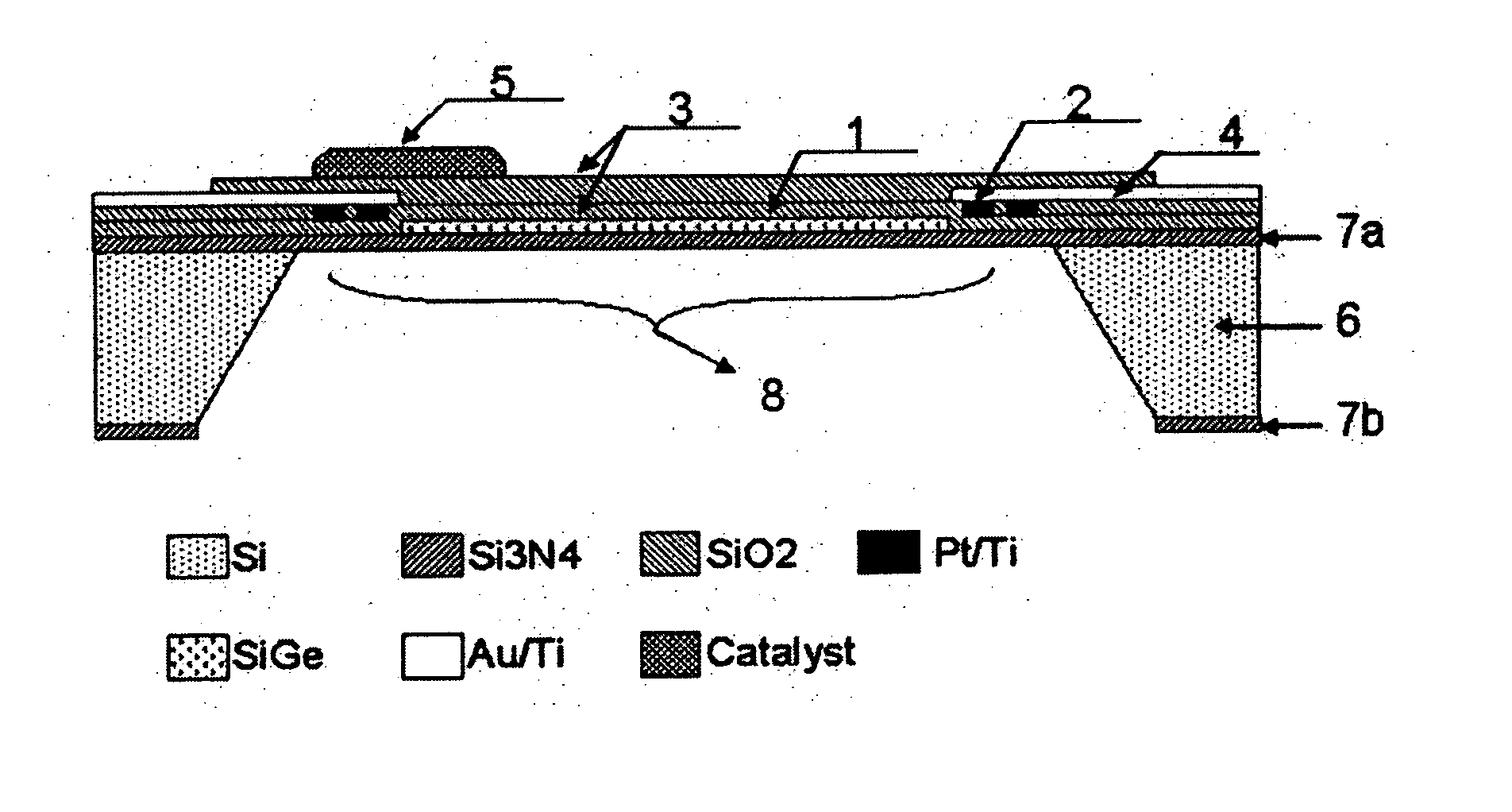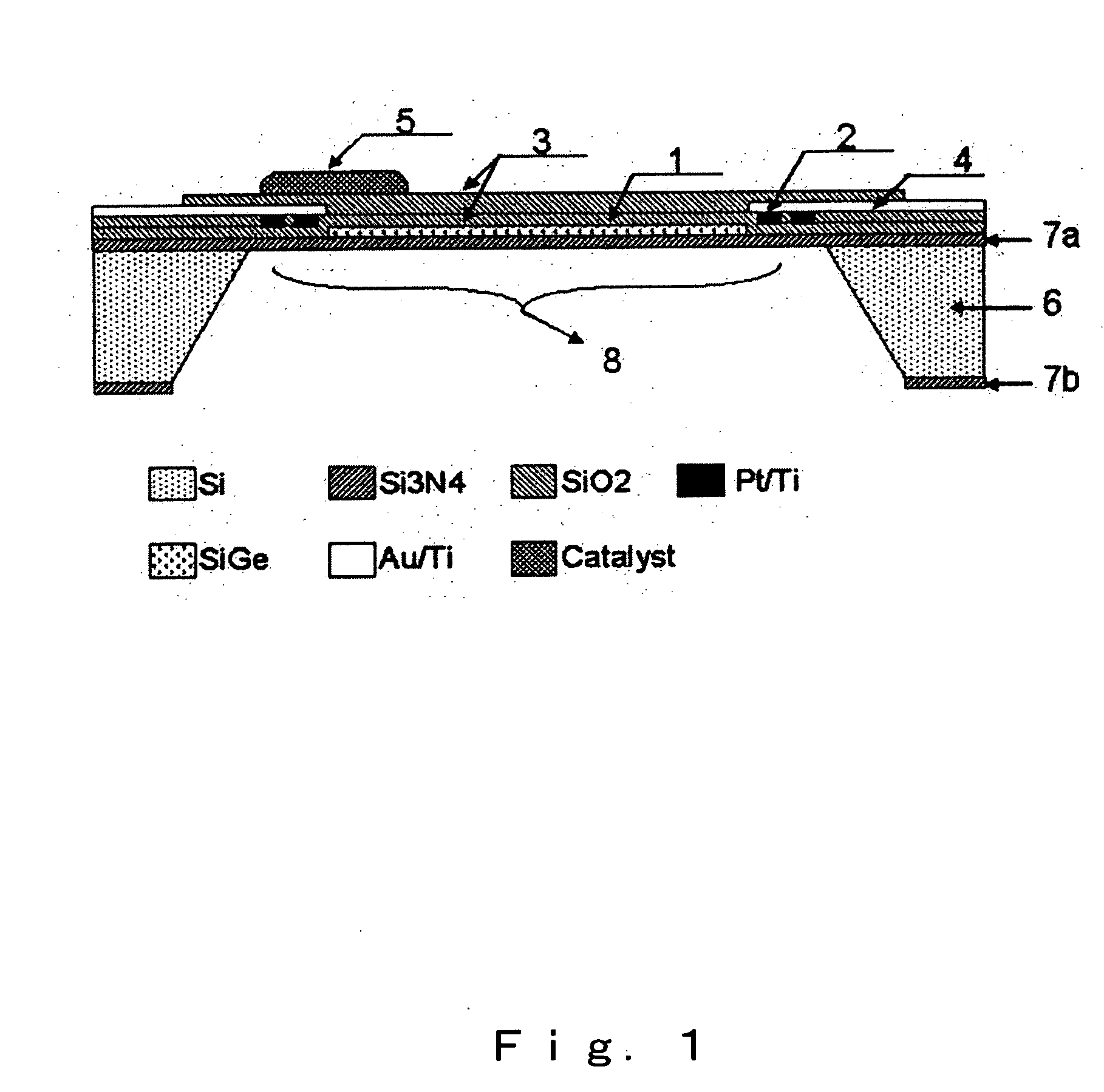Micro Thermoelectric Type Gas Sensor
a gas sensor and micro-element technology, applied in the field of micro-element structure thermoelectric gas sensor, can solve the problems of difficult miniaturization of sensor elements, high power consumption of several watts, sensor has a poor response of several minutes to temperature increase, etc., and achieves low power consumption, high sensitivity, and low power consumption
- Summary
- Abstract
- Description
- Claims
- Application Information
AI Technical Summary
Benefits of technology
Problems solved by technology
Method used
Image
Examples
embodiment 1
[0108] A specific feature of the micro thermoelectric sensor in accordance with the present invention that greatly differs in structure from the general micro gas sensors is that the microheater structure and thermoelectric thin film are formed at the same time. Because a membrane formed to provide for thermal shielding cracks easily from a level of 1 mm2, a large membrane is very difficult to produce. Accordingly, in the present embodiment, a micro thermoelectric hydrogen sensor was produced by fabricating a heater pattern, a thermoelectric pattern, and electrodes therefor within this surface area.
(1) Substrate
[0109] Because anisotropic etching of silicon is used in the fabrication of a microsensor, it is important to select appropriately the substrate and produce a film for etching stop. In the present embodiment, an oxide film and a nitride film were formed on a silicon substrate with a (100) plane and a thickness of about 300 μm. The oxide film was a thermal oxidation film gr...
embodiment 2
[0121] A gas response characteristic of the micro gas sensor was tested.
(1) Thermal Insulation by Membrane or Microheater
[0122]FIG. 5 shows a response characteristic to a 100 ccm flow of an air mixture gas containing 1% hydrogen when a microheater of a micro thermoelectric gas sensor was heated to 1001C. A generated voltage signal is plotted against the left axis, and the variations of temperature difference in a high-temperature portion and a low-temperature portion are plotted simultaneously against the right axis. By contrast when the film was formed on an alumina substrate, power consumption could be greatly reduced, and the consumed power was 50 mW at 100° C. for two membranes and 25 mW or less at 100° C. for one membrane element. Such low power consumption is due to excellent thermal insulation provided by the membrane structure and is a representative merit of the present microelement.
(2) Increase in Sensitivity
[0123] Owing to the thermal insulation effect, it was possi...
embodiment 3
[0128] In the present embodiment, pastes with various microstructures were produced and micropatterns of a catalyst were formed on a substrate by using a dispenser, as a preparatory test for finding a material for a paste to be used as a starting material for a functional material and for studying the relationship between the microstructure and the catalytic characteristic thereof.
(1) Preparation of Catalyst Powder and Paste Material
[0129] An aqueous solution of commercial platinum chloride and palladium chloride was prepared, immediately mixed with an oxide powder, and dried by heating to prepare a catalyst powder serving as a source starting material. The powder was mixed with a vehicle produced from terpineol and ethyl cellulose to prepare a paste-like functional material.
(2) Micropattern Formation with Dispenser
[0130] A catalyst was applied by using a dispenser to a predetermined position of an element and heated for 1 h at 300° C. to produce a catalyst. The catalyst was f...
PUM
 Login to View More
Login to View More Abstract
Description
Claims
Application Information
 Login to View More
Login to View More - R&D
- Intellectual Property
- Life Sciences
- Materials
- Tech Scout
- Unparalleled Data Quality
- Higher Quality Content
- 60% Fewer Hallucinations
Browse by: Latest US Patents, China's latest patents, Technical Efficacy Thesaurus, Application Domain, Technology Topic, Popular Technical Reports.
© 2025 PatSnap. All rights reserved.Legal|Privacy policy|Modern Slavery Act Transparency Statement|Sitemap|About US| Contact US: help@patsnap.com



